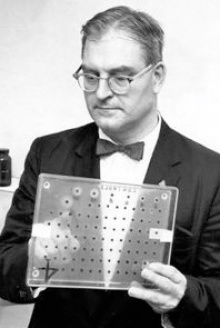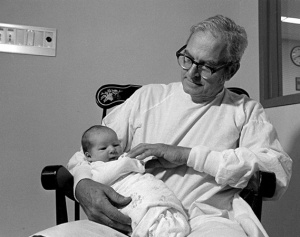Robert Guthrie, MD, PhD

Robert Guthrie, MD, PhD
Robert Guthrie was born on June 28, 1916, in Marionville, Missouri. His education as a physician and a scientist was circuitous but extensive, resulting in his earning six degrees across two institutions, including his MD in bacteriology in 1945 and his PhD in biochemistry in 1946 from the University of Minnesota.
Before his time in Buffalo, Dr. Guthrie had an extensive and varied research career, including roles as professor and chairman of the department of bacteriology and immunology at the University of Kansas (1949-1950), assistant in the department of chemotherapy at the Sloan-Kettering Institute (1951-1954), and principal cancer research scientist at Roswell Park Memorial Institute (1954-1958).
Eventually, he came to the University at Buffalo in 1958 as a research associate professor of pediatrics. He continued his research work at University of Buffalo as professor of microbiology (1970-1974), research professor of pediatrics (1971-1974) and professor of pediatrics and microbiology (1974-1986) until his retirement in 1986.
Dr. Guthrie was ultimately inspired to focus his research on the biological causes of mental retardation, and developmental disabilities after his son John was born with a mental disability in 1947. Nearly a decade later, his niece would also be diagnosed with phenylketonuria (PKU) a few months after her first birthday, further cementing his ambition to treat and prevent inherited metabolic disorders.
The problem at first seemed to be virtually intractable. In short, patients with inherited metabolic disorders have a malfunctioning gene that disrupts the normal chemical reactions by which the body converts nutrients into the molecules that it needs. This genetic malfunction can lead to serious biochemical changes in the body, resulting in a loss of essential molecules or a buildup of toxic precursors that are normally converted into other products for the cells.

When left untreated, these conditions can quickly lead to severe health consequences, including physical or mental disabilities or even death, which can begin to develop in early infancy. Given the time-critical nature of metabolic disease in infants, such disorders must be identified and properly treated within a very narrow window after birth.
Like the proverbial "needle in a haystack," the handful of children with such diseases needed to be found in a much larger population of unaffected children, and all within an extremely short window of time.
After several years of hard and often frustrating work, Dr. Guthrie was finally able to develop and implement a treatment program for one of these metabolic disorders in 1961.
As fate would have it, the disorder in question was phenylketonuria, the same disease that afflicted his niece in 1958.
The genius of the approach developed by Dr. Guthrie was in its simplicity and elegance. By simply collecting a small amount of blood from all newborns and running a simple biochemical test, one could cheaply and effectively sort through all newborns to find the handful of children who had the genetic predisposition toward a metabolic disorder. These children could then be given the appropriate treatment to avoid any future complications or disabilities.
Today, Dr. Guthrie is celebrated around the world for his groundbreaking work at UB in the development of newborn screening for inherited metabolic disorders.
Sometimes referred to as the “Guthrie test” or the “heel prick” test, the screening approach that he helped pioneer is widely acknowledged as one of the most cost-effective and successful public health programs of the last century.
In the following decades, the screening strategy developed in Dr. Guthrie’s work has been used as the basis for dozens of other tests that are used today to diagnose and treat metabolic and genetic disorders starting just after birth.
These tests have helped save many lives and have helped preserve the health and well-being of tens of thousands of children.